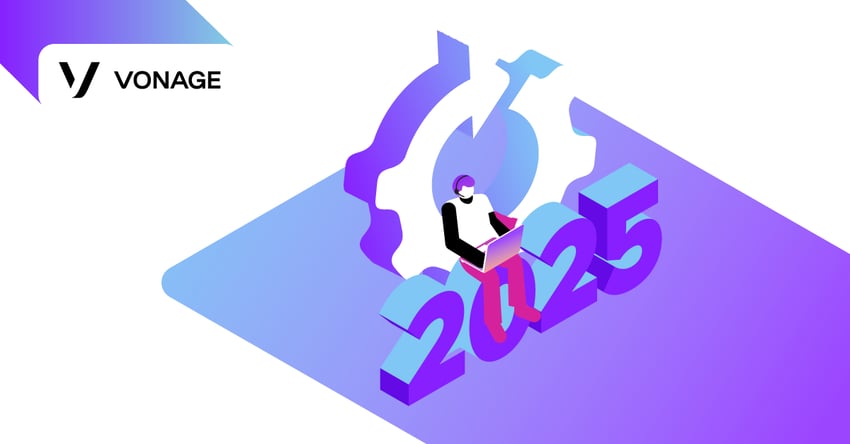5 Ways the Contact Center Will Evolve by 2025
Customer service expectations have rapidly evolved during the COVID-19 pandemic. Customers are using a greater variety of communication channels than ever before, and they expect brands to provide multiple avenues for prompt engagement.

How businesses respond, specifically with their contact center capabilities, will determine their future competitiveness. According to Gartner's research on top customer service and support predictions for 2021 and beyond, 40% of customer service organizations will become profit centers by 2025—and they'll accomplish this transition by becoming de facto leaders in customer engagement.
Companies will place a premium on timely, proactive, and tailored customer engagement in the coming years. As they do, they'll adopt an array of technologies to deliver responsive and satisfying service. Here's a look at how customer service business needs will evolve during this time frame and how contact center capabilities will deliver increasingly sophisticated and cohesive customer experiences.
1. Companies Will Proactively Engage Customers
Customers usually initiate conversations with companies, and they typically only reach out when they have a question or a problem. Companies can make a positive impression by quickly and successfully fulfilling the customer's request, but they're still in a reactive posture. Forward-thinking customer service teams know they have an opportunity to deepen customer relationships by taking the initiative.
According to Gartner, the conditions created by the pandemic have inspired companies to proactively engage customers. In the future, they will advise customers about self-help options in advance and intentionally foster relationships with them before they contact customer service. Companies can tap the artificial intelligence (AI) self-service capabilities in cloud contact center software to proactively build stronger and more profitable customer relationships while reducing incoming call volume.
2. Messaging and Third-Party Apps Will Become More Prominent
Messaging apps were one of the top engagement technologies of 2020, and with good reason. According to Vonage's research, 23% more consumers chose messaging apps as a top-three method for calling businesses in 2020. During the same period, all other calling methods (mobile, phone, landline, and click-to-call from a website or app) lost ground. Gartner predicted that 80% of customer service organizations will replace native mobile apps with messaging by 2025.
Businesses that want to proactively engage customers on messaging apps can extend their contact center's capabilities with communication application programming interfaces. For example, they can use Facebook Messenger to give customers proactive personalized support with in-app messaging, voice, and AI. Likewise, they can tap WhatsApp to provide a more engaging customer experience, enriching images, audio, video, and files as desired.
3. Companies Will Adopt a Channel-Neutral Mindset
Customers want to engage brands across a variety of channels. According to Vonage's research on global customer engagement trends, the pandemic further diversified consumer channel preferences. In fact, customers said that one of their greatest frustrations is when they call a business or service provider for help and no service representatives are available, but they aren't offered any other channels to resolve their issue.
Companies have a clear opportunity to improve the customer experience by adopting an omnichannel approach to customer engagement. Gartner predicted that companies will shift toward a channel-neutral mindset in the coming years, adopting an outside-in approach and designing experiences with a multi-experience mindset.
The omnichannel contact center will be a strategic asset where this is concerned, enabling brands to seamlessly communicate with their customers across all the channels where they spend their time—whether that's voice, video, text messaging, chat, social media, email, or new channels that haven't yet emerged.
4. Customer Service Will Include IoT Devices
Speaking of new channels, the Internet of Things (IoT) is also poised to have a strong impact on the customer experience during this time frame. According to Gartner's predictions, businesses will need to be prepared to not only engage customers but also service their IoT devices. Connected devices are assuming an ever more expansive role in customers' lives, flashing push notifications on their wrists and providing voice-activated assistance on-demand in smart home settings.
As ReadWrite pointed out, IoT technology plays a vital role in providing a positive customer experience. For example, companies can tap IoT sensor data to resolve potential problems before they even occur. They can also use analytics insights to improve service, training staff to improve the overall quality of the business offerings they provide. The cloud contact center can help companies prepare for the connected customer experience by integrating with new and emerging technologies. It can also be used to effectively train and onboard customer service professionals, ensuring that the company consistently delivers top-notch service as customer engagement trends evolve.
5. Companies Will Deliver Specialized Customer Service
According to Gartner, the old model of "escalate and wait" does not meet customers' expectations for modern digital-first service. This trend will intensify, and service organizations will have to adapt accordingly. Gartner predicts that by 2025, 10% of customer service organizations will revamp hierarchical staffing models to create "huddle groups" devoted to the well-being of specific customer segments. These huddle groups will be cross-functional, scalable, and designed according to categories such as industry, product class, or subscription type.
Contact center technology will play a strong role in enabling this specialized customer service. For example, customer service teams will leverage analytics to better understand the types of customers they serve and pinpoint gaps in their respective experiences. Dynamic routing features will connect customers with specialists in huddle groups that can help them with their unique needs, ensuring they get the tailored service they require.
Evolve Your Customer Service With the Contact Center
Customer service requirements dramatically changed during the pandemic, and they're about to transform again. Customers expect companies to be available and responsive on multiple channels, proactively offering them self-help options and delivering tailored service to meet their unique needs. Businesses can leverage contact center capabilities to fulfill customer service expectations as they evolve, setting themselves up for future success.